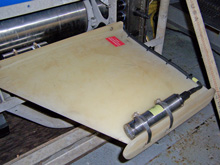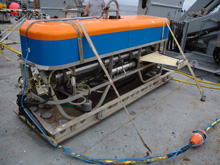How Old Is It? Using Magnets to Determine Age
December 22, 2005
Scott “Captain Magneto” White
Marine Geologist and Magnetic Personality
The DSL120 tow sled is primarily designed to collect high-resolution side scan sonar data of the seafloor, but it can also carry many additional sensors. Other logs have already described the numerous hydrothermal sensors on the DSL120. On this voyage, we are collecting magnetic field data from very sensitive magnetometers mounted on the DSL120 sonar sled. Towing the magnetometers close to the seafloor allows us to detect tiny changes in the Earth’s magnetic field as the sonar sled flies over the seafloor.
You may already be familiar with the Earth’s magnetic field from using a compass to find which way is north. A compass needle is made out of iron magnetite, a mineral particularly abundant in basalt, the primary rock that makes up the seafloor. The same forces that make a compass needle point north also align small magnetite crystals in the basalt while it is still molten. When basalt rock is molten, the minerals that compose the rock move easily and align themselves in the direction of the Earth’s magnetic field - magnetic north and south. As the molten rock cools, the alignment of the magnetite mineral becomes frozen in the rock, permanently recording the direction of the earth’s magnetic field at that point in time. Even if the earth’s magnetic field changes (which last occurred about 780,000 years ago), the magnetic alignment in the rock will remain the same. So geologists can look at the magnetic orientation of iron magnetite crystals in the rock and gain an idea of the rock’s age.
The magnetometers on board the DSL120 can determine the current direction of magnetic north, and also tell us the strength of magnetic force. Very small changes in that magnetic field detected by the magnetometer may indicate the presence of recently erupted lava flows or rocks altered by hydrothermal fluid passing through them. Although magnetic signatures are “locked into” basalt rock as it cools, some factors alter the magnetic signature. Extremely hot, hydrothermal waters chemically interact with iron magnetite, changing its composition and causing it to lose its magnetic signature.

On this voyage, we are collecting magnetic field data from very sensitive magnetometers mounted on the DSL120 sonar sled. Towing the magnetometers close to the seafloor allows us to detect tiny changes in the Earth’s magnetic field as the sonar sled flies over the seafloor. Click image for larger view and image credit.

The steel frame of the DSL120 can create changes in the magnetic field measured by the magnetometer. To reduce this effect we mount the magnetometer in a separate pressure case strapped to the wing of towed sled, and execute a 360-degree spin during ascent or descent through the water column to calculate how the metal in the sled affects the north direction reading of the magnetometer. Click image for larger view and image credit.
Several other factors not related to geology will also create changes in the magnetic field measured by the magnetometers too. A big factor is the steel frame of the DSL120 itself. To reduce this effect we mount the magnetometer in a separate pressure case strapped to the wing of towed sled (see above photo), and execute a 360-degree spin during ascent or descent through the water column to calculate how the metal in the sled affects the north direction reading of the magnetometer. We also will correct the data for effects caused by the changing height of the sonar sled from the seafloor. Like much of the data collected by instruments out at sea, adjustments will need to be made to the data to account for a number of variables before we are finally able to turn the data we collect into useful information that may reveal locations of eruptions and hydrothermal activity on the seafloor.
Fast Fact
Did you know that no one knows how many hundreds to thousands of miles deep in the earth lies the source of lava flows in the Galapagos Spreading Center?
Sign up for the Ocean Explorer E-mail Update List.




























